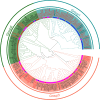N123I mutation in the ALV-J receptor-binding domain region enhances viral replication ability by increasing the binding affinity with chNHE1
- PMID: 38324558
- PMCID: PMC10878525
- DOI: 10.1371/journal.ppat.1011928
N123I mutation in the ALV-J receptor-binding domain region enhances viral replication ability by increasing the binding affinity with chNHE1
Abstract
The subgroup J avian leukosis virus (ALV-J), a retrovirus, uses its gp85 protein to bind to the receptor, the chicken sodium hydrogen exchanger isoform 1 (chNHE1), facilitating viral invasion. ALV-J is the main epidemic subgroup and shows noteworthy mutations within the receptor-binding domain (RBD) region of gp85, especially in ALV-J layer strains in China. However, the implications of these mutations on viral replication and transmission remain elusive. In this study, the ALV-J layer strain JL08CH3-1 exhibited a more robust replication ability than the prototype strain HPRS103, which is related to variations in the gp85 protein. Notably, the gp85 of JL08CH3-1 demonstrated a heightened binding capacity to chNHE1 compared to HPRS103-gp85 binding. Furthermore, we showed that the specific N123I mutation within gp85 contributed to the enhanced binding capacity of the gp85 protein to chNHE1. Structural analysis indicated that the N123I mutation primarily enhanced the stability of gp85, expanded the interaction interface, and increased the number of hydrogen bonds at the interaction interface to increase the binding capacity between gp85 and chNHE1. We found that the N123I mutation not only improved the viral replication ability of ALV-J but also promoted viral shedding in vivo. These comprehensive data underscore the notion that the N123I mutation increases receptor binding and intensifies viral replication.
Copyright: © 2024 Yu et al. This is an open access article distributed under the terms of the Creative Commons Attribution License, which permits unrestricted use, distribution, and reproduction in any medium, provided the original author and source are credited.
Conflict of interest statement
The authors have declared that no competing interests exist.
Figures







Similar articles
-
The Bipartite Sequence Motif in the N and C Termini of gp85 of Subgroup J Avian Leukosis Virus Plays a Crucial Role in Receptor Binding and Viral Entry.J Virol. 2020 Oct 27;94(22):e01232-20. doi: 10.1128/JVI.01232-20. Print 2020 Oct 27. J Virol. 2020. PMID: 32878894 Free PMC article.
-
Residues 28 to 39 of the Extracellular Loop 1 of Chicken Na+/H+ Exchanger Type I Mediate Cell Binding and Entry of Subgroup J Avian Leukosis Virus.J Virol. 2017 Dec 14;92(1):e01627-17. doi: 10.1128/JVI.01627-17. Print 2018 Jan 1. J Virol. 2017. PMID: 29070685 Free PMC article.
-
Identification of a novel B-cell epitope specific for avian leukosis virus subgroup J gp85 protein.Arch Virol. 2015 Apr;160(4):995-1004. doi: 10.1007/s00705-014-2318-6. Epub 2015 Feb 6. Arch Virol. 2015. PMID: 25655260
-
Gp85 genetic diversity of avian leukosis virus subgroup J among different individual chickens from a native flock.Poult Sci. 2017 May 1;96(5):1100-1107. doi: 10.3382/ps/pew407. Poult Sci. 2017. PMID: 27794054
-
Recombinant invasive Lactobacillus plantarum expressing the J subgroup avian leukosis virus Gp85 protein induces protection against avian leukosis in chickens.Appl Microbiol Biotechnol. 2022 Jan;106(2):729-742. doi: 10.1007/s00253-021-11699-9. Epub 2021 Dec 31. Appl Microbiol Biotechnol. 2022. PMID: 34971411
Cited by
-
Rapid adaptive evolution of avian leukosis virus subgroup J in response to biotechnologically induced host resistance.PLoS Pathog. 2024 Aug 15;20(8):e1012468. doi: 10.1371/journal.ppat.1012468. eCollection 2024 Aug. PLoS Pathog. 2024. PMID: 39146367 Free PMC article.
-
N6-methyladenosine modification of the subgroup J avian leukosis viral RNAs attenuates host innate immunity via MDA5 signaling.PLoS Pathog. 2025 Apr 8;21(4):e1013064. doi: 10.1371/journal.ppat.1013064. eCollection 2025 Apr. PLoS Pathog. 2025. PMID: 40198675 Free PMC article.
-
Isolation and molecular characteristic of subgroup J avian leukosis virus in Guangxi and Jiangsu provinces of China during 2022-2023.Poult Sci. 2025 Aug;104(8):105272. doi: 10.1016/j.psj.2025.105272. Epub 2025 May 7. Poult Sci. 2025. PMID: 40367569 Free PMC article.
-
Autophagy-mediated TET2 degradation by ALV-J Env protein suppresses innate immune activation to promote viral replication.J Virol. 2025 Feb 25;99(2):e0200324. doi: 10.1128/jvi.02003-24. Epub 2025 Jan 22. J Virol. 2025. PMID: 39840982 Free PMC article.
-
Identification of Cables1 as a critical host factor that promotes ALV-J replication via genome-wide CRISPR/Cas9 gene knockout screening.J Biol Chem. 2024 Nov;300(11):107804. doi: 10.1016/j.jbc.2024.107804. Epub 2024 Sep 21. J Biol Chem. 2024. PMID: 39307305 Free PMC article.
References
-
- Payne LN. Biology of Avian Retroviruses. In: Levy J.A.(eds) The Retroviridae. The Viruses. Springer, Boston, MA. 1992. 10.1007/978-1-4615-3372-6_6. - DOI
MeSH terms
Substances
LinkOut - more resources
Full Text Sources

